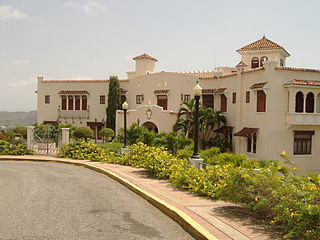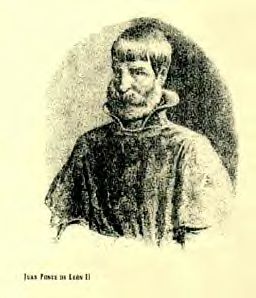
Ponce is a city and a municipality on the southern coast of Puerto Rico. The most populated city outside the San Juan metropolitan area, was founded on August 12, 1692 and is named after Juan Ponce de León y Loayza, the great-grandson of Spanish conquistador Juan Ponce de León. Ponce is often referred to as La Perla del Sur, La Ciudad Señorial, and La Ciudad de las Quenepas.

Juan Ponce de León was a Spanish explorer and conquistador known for leading the first official European expedition to Puerto Rico in 1508 and Florida in 1513. He was born in Santervás de Campos, Valladolid, Spain, in 1474. Though little is known about his family, he was of noble birth and served in the Spanish military from a young age. He first came to the Americas as a "gentleman volunteer" with Christopher Columbus's second expedition in 1493.
The municipalities of Puerto Rico are the second-level administrative divisions in the Commonwealth of Puerto Rico. There are 78 such administrative divisions covering all 78 incorporated towns and cities. Each municipality is led by a mayor and divided into barrios, third-level administrative divisions, though the latter are not vested with any political authority. Every municipality is governed as stated by the Autonomous Municipalities Act of 1991, which establishes that every municipality must have an elected strong mayor with a municipal legislature as the form of government. Each legislature must be unicameral, with the number of members related to adequate representation of the total population of the municipality. In contrast to other jurisdictions, both the mayors and the municipal legislators are elected on the same date and for the same term of four years in office.
Santa Rosa is the Italian, Portuguese, and Spanish name for Saint Rose.

Guánica is a town and municipality in southern Puerto Rico, bordering the Caribbean Sea, south of Sabana Grande, east of Lajas, and west of Yauco. It is part of the Yauco metropolitan statistical area.

Juan Ponce de León II (1524–1591) was a Spanish official and an acting governor of Puerto Rico. He was the first acting governor to be born on the island.
Juan Ponce de León (1474–1521) was an early Spanish explorer who is credited as being the first European to land in North America, and was the first colonial governor of Puerto Rico.

Pascua Florida is a Spanish term that means "flowery festival" or "feast of flowers" and is an annual celebration of Juan Ponce de León's arrival in what is now the state of Florida. While the holiday is normally celebrated on April 2, it can fall on any date between the latter parts of March and the first week of April, depending on the day of the week April 2 falls on and/or the Governor's discretion. Pascua Florida Day is a state holiday.
Santervás de Campos is a municipality located in the province of Valladolid, Castile and León, Spain. As of 2009, the municipality has a population of 137 inhabitants and is known as the birthplace of Juan Ponce de León.

Agüeybaná II, born Güeybaná and also known as Agüeybaná El Bravo, was one of the two principal and most powerful caciques of the Taíno people in Borikén when the Spaniards first arrived in Puerto Rico on November 19, 1493. Agüeybaná II led the Taínos of Puerto Rico in the Battle of Yagüecas, also known as the Taíno rebellion of 1511, against Juan Ponce de León and the Spanish Conquistadors.

Mercado de las Carnes, also known as La Plaza de los Perros, but formally, Plaza Juan Ponce de León, was the first building in Puerto Rico to mix social and architectural elements via the pedestrian mall concept. The historic Art Deco architecture structure is located in Ponce, Puerto Rico, and dates from 1926. It was listed on the National Register of Historic Places in 1986. The Plaza was rebuilt in 1992, under the administration of Mayor Churumba. It is located in the alley connecting Mayor and Leon streets, in the block between Estrella and Guadalupe streets. The Plaza and the alley are one and the same.
The 2010 FC Tampa Bay season was the first and inaugural season of FC Tampa Bay and only season in the USL Conference of the USSF Division 2 Professional League, the second tier of the American Soccer Pyramid. The USSF D-2 was a temporary professional soccer league created by the United States Soccer Federation (USSF) in 2010 to last just one season, as a compromise between the feuding United Soccer Leagues (USL) and the North American Soccer League (NASL).
Cruz is a surname of Iberian origin.
2011 FC Tampa Bay season was the second in the club's existence and the first in the NASL.
The barrios of Puerto Rico are the primary legal divisions of the seventy-eight municipalities of Puerto Rico. Puerto Rico's 78 municipios are divided into geographical sections called barrios and, as of 2010, there were 902 of them. In the US Census a barrio sometimes includes a division called a comunidad or subbarrio. In Puerto Rico, barrios are composed of sectors. The types of sectors (sectores) may vary, from normally sector to urbanización to reparto to barriada to residencial, among others.
Juan Ponce de León (1474–1521) was a Spanish explorer known for seeking the Fountain of Youth and the first Governor of Puerto Rico.
Ponce is a surname or part of a surname. Notable people with the surname include:

San Juan Bay is the bay and main inlet adjacent to Old San Juan in northeastern Puerto Rico. It is about 3.5 miles (5.6 km) in length, the largest body of water in an estuary of about 97 square miles (250 km2) of channels, inlets and eight interconnected lagoons. The San Juan Bay is home to the island's busiest harbor and its history dates back to at least 1508.
Spanish settlement of Puerto Rico began in the early 1500s shortly after the formation of the Spanish state in 1493 and continues to the present day.
Pueblo is a term primarily used in Puerto Rico to refer to the municipal district (barrio) that serves as the administrative, historic and cultural center of a municipality. The concept of pueblo is often used locally as analogous to the concept of downtown in U.S. cities. Pueblos are officially called barrio-pueblo by the United States Census since 1990.






